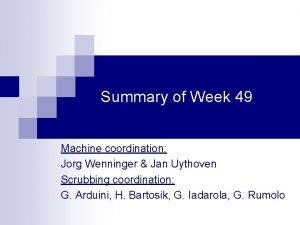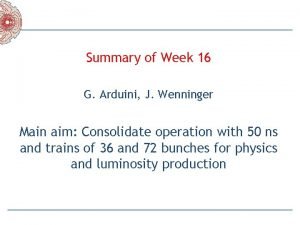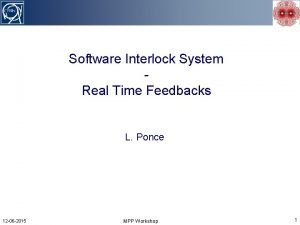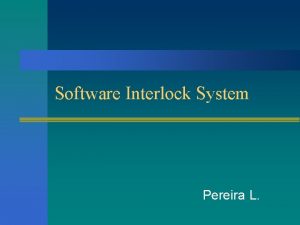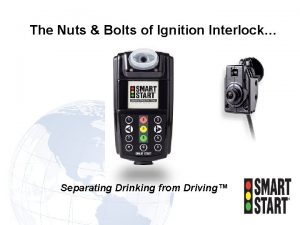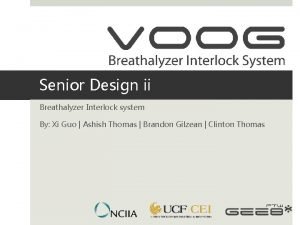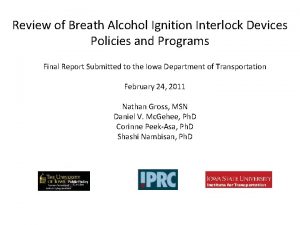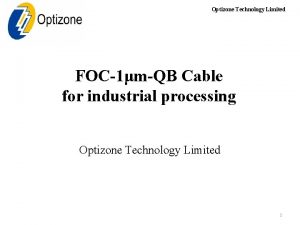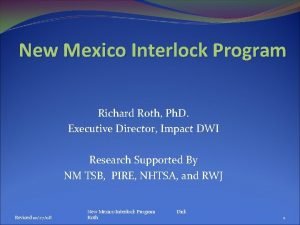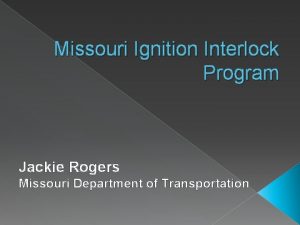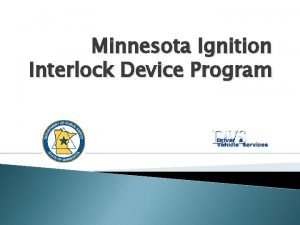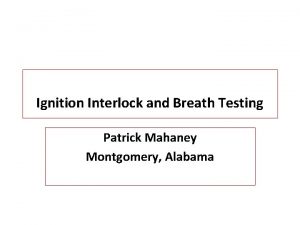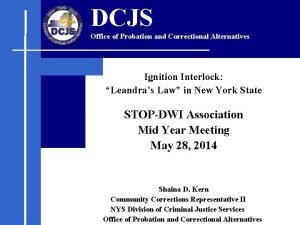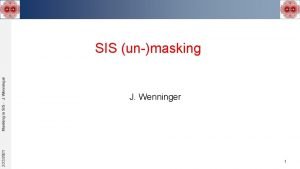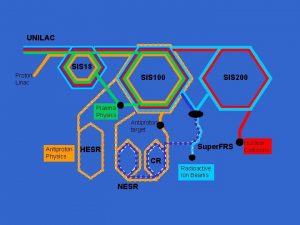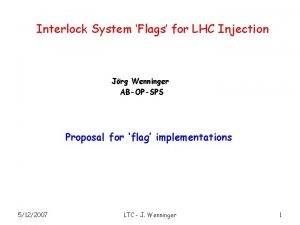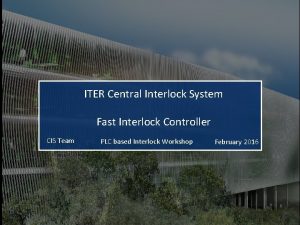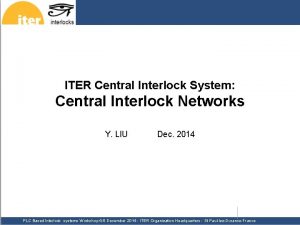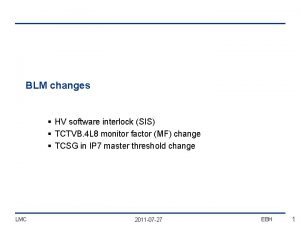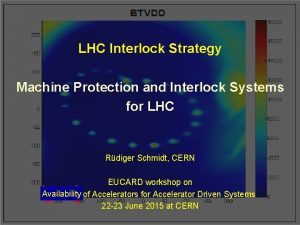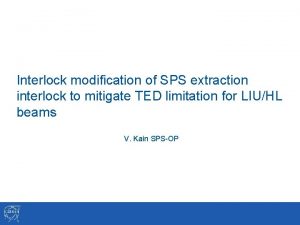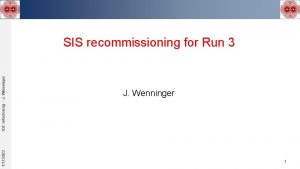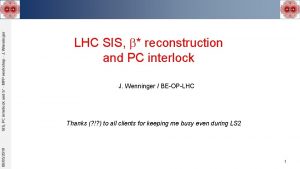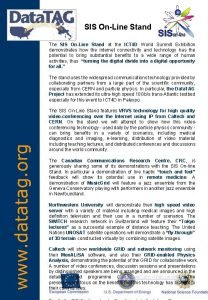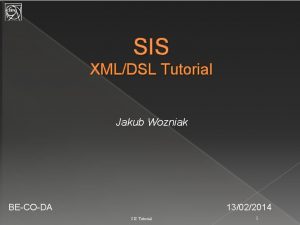Software Interlock System J Wenninger SIS team L

















- Slides: 17

Software Interlock System J. Wenninger SIS team: L. Pereira , L. Ponce, J. Wenninger, J. Wozniak (LP 2 + JW 2) 2/26/2021 MPS Internal Review : SIS / J. Wenninger 1

SIS Overview q q SIS @ LHC used for: o Injection interlocking. o Circulating beam interlocking ( dump). o Powering & access interlocking – not for today. o Beta* reconstruction and publication (via MTG) – not for today. To perform its job @ LHC: o SIS has subscriptions to 2409 control system devices / parameters. o SIS exports signals to: 2/26/2021 o BICs (8 signals) update period 2 s o MTG (2 signals) update period of 4 s o PICs (36 signals) update period of 2 s MPS Internal Review : SIS / J. Wenninger BIC timeout 20 s 2

SIS Overview q q q Interlock types: o Initially: used simple test logic comparison of acquired value to reference value (number or boolean) – hardcoded into configuration. o Now: more and more complicated interlocks (JAVA) that pull together multiple signals and DB references. Very flexible, but complex interlocks are tricky to test ! For the moment all interlocks are maskable except: o XPOC o BIC pre-operational checks o LHCf injection inhibit. Masking: o Independent of SBF. o Allowed for all holders of RBAC roles : LHC-EIC, MCS-SIS 2/26/2021 MPS Internal Review : SIS / J. Wenninger 3

SIS Availability q LHC SIS runs on dedicated HP server in the CCR. o q The server is equipped with a timing card (CTRI). The SIS processes of SPS and LHC have never failed during operation in the last 2 years. Server crashes were however observed in the 2009 -10 shutdown. This was traced to a timing library (concurrency) and fixed. o In case of failure the timeouts on the SIS inputs to the BICs lead to beam dump/injection or extraction inhibit. o 2/26/2021 MPS Internal Review : SIS / J. Wenninger 4

SIS Injection Interlocks Test Coverage Status PC states All PCs Operational PC currents RB, RQ, RD, MCBX Operational QPS_OK All circuits with QPS Operational RF Synchronization Cryo maintain Operational A few interlocks on f. RF to come BTV position Ring and dump line BTVs Operational Dump BTV not tested with intensity (more int. needed) Injection bucket Abort gap and overinjection protection Operational Some issues with BQM reliability Injection mode Operational Avoid injecting with wrong mode Energy Operational (Pre)-op checks XPOC, PM, IQC, BIC LHCf Triplet alignment 2/26/2021 Extend to IPQ? Operational WPS in all IRs Comments via DIP Operational MPS Internal Review : SIS / J. Wenninger 5

Injection summary q Large number of interlocks (> 3000!): o Very high reliability given the number of signals. o Loosing one injection is not too dramatic – can afford to be tough, but must avoid too many false decision (credibility !). o A few more interlocks to come… o Availability issues: 2/26/2021 o BQM – issue with the crate for beam 1. o LHCf in 2009 – ‘solved’. MPS Internal Review : SIS / J. Wenninger 6

SIS Circulating Beam Interlocks Test Coverage Status Comments SMP energy All RBs, SMP energy Operational 0. 2% to 1%, relax with faster ramp? SMP energy distribution All BLM crates Operational Verify energy across all BLM crates BETS Q 4 and MSD in IR 6 Masked Ready to go TCDQ – beam Beam center in TCSG gap TCDQ-TCSG retraction Operational Masked Achievable tolerances depend on orbit stability COD integral All arc Hor. CODs Operational dp/p < 0. 2% Orbit All ring BPMs Operational Achievable tolerances depend on orbit stability COD settings All CODs Operational in Achievable tolerances depend stable beams on reproducibility and variation in ramp & squeeze COD trips 2/26/2021 60 A CODs (not in PIC) Masked Dump if COD(s) trips and missing kick > threshold. NEW. MPS Internal Review : SIS / J. Wenninger 7

Orbit and COD interlocking q Principle: o Limit global orbit excursions. o Catch un-detected orbit bumps (via COD settings). o Interlocks settings per COD/monitor: - Reference, tolerance, enable flag. q Tolerances are a balance between safety, availability and interlock complexity. o So far the tolerance settings were limited by beam excursion in ramp and squeeze. Much better now with OFB. o Ramp and squeeze cleanup will also allow for tigh(er) COD interlocks. 2/26/2021 MPS Internal Review : SIS / J. Wenninger 8

Orbit interlocking q Enforce overall orbit envelope. Present settings: o Per plane and beam accept max of 10 BPMs out of tolerance. o Faulty BPMs are ignored. o Tolerances (wrt ref) stable beams : 2. 5 mm IR 1, 2, 5, 8, 2 mm elsewhere o Tolerances (wrt ref) other modes : 6 IR 1, 2, 5, 8, 3 -3. 5 mm elsewhere - larger tolerance in IRs to cover separation ON/OFF phases. >> Provides de facto an energy offset interlock of 0. 1 -0. 2 %. q Tolerances o can now be significantly tightened with OFB. Could reduce tolerances to around 1 mm (at least in arcs + IR 3, 4, 6, & 7), maybe even less for stable beams. - Could be a problem at injection (before orbit corrected). Deactivate automatically if intensity < 5 E 10 & injection energy? 2/26/2021 MPS Internal Review : SIS / J. Wenninger 9

COD settings q Aim is to catch bump-like structure that are only visible on few BPMs. o Simple logic: trigger when 2 kicks are out of tolerance (pi-bump like, but also for ‘larger’ bumps). o Could be made more intelligent – but would involve more complex dependence (optics…). o Settings stable beams : 50 mrad IR 1, 2, 5, 8 (sep. scans), 25 mrad elsewhere probably possible to reduce with OFB (not IR 1, 2, 5 and 8). o Settings other modes : to be defined. One value + tolerances per COD to cover ramp and squeeze. q Complex o changes of COD settings in ramp and squeeze: Need SW to analyze changes and define tolerances around required operational margin (in preparation…). But this also needs a number of ramps in regular operation to define reliable limits. 2/26/2021 MPS Internal Review : SIS / J. Wenninger 10

Orbit interlocking in steering q Display of orbit and COD interlock settings together with actual data, and handling of settings in the steering application. 2/26/2021 MPS Internal Review : SIS / J. Wenninger 11

TCDQ orbit interlocking q Ensures beam centered in TCSG ( offset wrt TCDQ): o Present setting : tolerance of 2 mm (independent of E). o Limited so far by: q Very o Orbit changes in ramp & squeeze >> solved now by OFB. o Intensity dependence (BPMSB – the worst guys !). o Collimator gap consistency (injection stable beams). efficient – triggered already a few times – no false decision. q With OFB active, the interlock windows can be reduced – exact values to be confirmed. o Tolerance: 1 mm is in reach (1. 5 sigma @ 3. 5 Te. V). 2/26/2021 MPS Internal Review : SIS / J. Wenninger 12

COD trips q 60 o A arc CODs are not interlocked by PIC. Presently a PC trip does not lead to a beam dump (only injection inhibit via SIS !). q New interlock in SIS to catch 60 A trips: o Monitor all 60 A states and detect any PC failure. o Dump beam if the total kick of failing PC(s) exceeds a threshold (so far 10 mrad). o Tested at 450 Ge. V and ready to go… 2/26/2021 MPS Internal Review : SIS / J. Wenninger 13

Settings management q Settings for orbit, COD and TCDQ interlocks are ‘virtual’ critical devices in LSA – digitally signed (role LHC-MCS-SIS). o Requires regular updates to follow evolution of the machine. o This will hopefully become more stable soon…. o So far I manage all the settings – need some people to back me up ! 2/26/2021 MPS Internal Review : SIS / J. Wenninger 14

Running faster? q SIS o evaluates its checks every 2 seconds. Server CPU load ~ 20 -30% q Main clients provide data at 1 Hz or less. o Orbit at 1 Hz. o PC states and currents at 0. 5 Hz. >> Could move to 1 s period – but gain is probably marginal. 2/26/2021 MPS Internal Review : SIS / J. Wenninger 15

Safety… q Protection o of the subscription UI. Avoid accidental stopping of data subscription – mostly availability, but also safety when there are timeouts. q Masking. o So far masking rights apply to all signals. Could consider making masking role-dependent. o Could consider making masks of selected interlocks SBF dependent. - not clear how much work this implies. 2/26/2021 MPS Internal Review : SIS / J. Wenninger 16

Summary q SIS q It is a reliable solution for quite a class of interlocks: o Injection interlocks (reliability less critical). o (Complex) interlocks involving multiple systems. o Interlocks for distributed systems like orbit. o Quick solutions for un-expected situations. is all software: o Reaction time limited to around 1 second. o Safety will never be SIL 3… even if it is better than what I would have expected some years ago. q Interlocks on orbit and CODs: o Quite powerful – but require constant checking to follow evolution of the machine. o One can do better – but watch out for the settings nightmare ! 2/26/2021 MPS Internal Review : SIS / J. Wenninger 17
 Jorg wenninger
Jorg wenninger Wenninger compressor
Wenninger compressor Sis interlock
Sis interlock Software interlock
Software interlock Software interlock
Software interlock Team spirit becomes team infatuation
Team spirit becomes team infatuation Team spirit becomes team infatuation
Team spirit becomes team infatuation The white team cheers for the blue team, just like
The white team cheers for the blue team, just like What does a smart start report look like
What does a smart start report look like Ignition interlock device hack
Ignition interlock device hack Ignition interlock device reviews
Ignition interlock device reviews Interlock loop
Interlock loop New mexico interlock laws
New mexico interlock laws Nm interlock indigent fund
Nm interlock indigent fund Ignition interlock missouri
Ignition interlock missouri Ignition interlock program mn
Ignition interlock program mn Patrick mahaney
Patrick mahaney Ignition interlock coffee cup
Ignition interlock coffee cup
